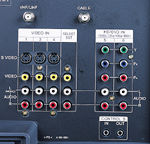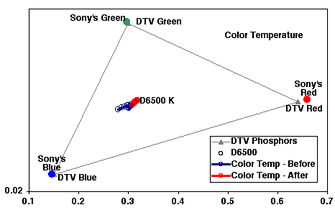The Monster TV Face Off Sony KDP-57XBR2
Like RCA's P61310, the Sony KDP-57XBR2 earns the acronym HDTV, as opposed to the term HD monitor. The latter means that a display can receive regular television signals and is capable of scanning at the higher frequency of HD signals, but it doesn't receive the HD signals in and of itself. In order for you to actually watch HD signals on these displays, you must connect an outboard HDTV tuner. The KDP-57XBR2, on the other hand, has a built-in digital tuner and therefore can rightfully be referred to as a true HDTV.

Granted, the tuner only brings in terrestrial (i.e., over-the-air) signals, which may or may not be abundant in your area. When you can get them, though, these are the best-quality high-definition signals you can view. Fortunately, two of the set's many inputs will accept HD signals from any existing external satellite or cable tuner, as well, and future IEEE 1394-equipped devices will find homes with the pair of connectors that Sony refers to as "iLink." No need to spend money on an upgrade later. In addition to all of the video flexibility, the built-in tuner offers Dolby Digital sound with an optical output or enough regular outputs to build a sound system around the TV.
 All of these input and output options are easy to manage with the set's silver remote and attractive onscreen interface. The menu system is easy to navigate, and the remote is reasonably uncluttered. The controller includes buttons that allow you to toggle through various preset picture-preference modes so that you can make the image bright and punchy during the day or more-subdued at night. You can even toggle through various line-doubler (Sony calls it DRC) modes. The film mode did one of the better jobs of eliminating motion artifacts in film-sourced DVDs. Unfortunately, you have to toggle through inputs, as well. With as many as there are, this ends up being a bit of a chore.
All of these input and output options are easy to manage with the set's silver remote and attractive onscreen interface. The menu system is easy to navigate, and the remote is reasonably uncluttered. The controller includes buttons that allow you to toggle through various preset picture-preference modes so that you can make the image bright and punchy during the day or more-subdued at night. You can even toggle through various line-doubler (Sony calls it DRC) modes. The film mode did one of the better jobs of eliminating motion artifacts in film-sourced DVDs. Unfortunately, you have to toggle through inputs, as well. With as many as there are, this ends up being a bit of a chore.
 Fortunately, you can set up each picture mode the way you like it, although some of them look better than others. For example, in the movie mode, the DC restoration becomes slightly more stable and the SVM turns itself off. This is good if you want an accurate picture. Adrienne pointed out that the lack of SVM and the comb filter's lack of dot crawl made the picture very sharp. Although the color decoder pushes red slightly, she didn't find it objectionable. In fact, the Kid felt that the mild red push helped Ewan McGregor, playing the young Obi Wan Kenobi, look more natural, given the rest of the picture's otherwise-bluish cast. He also appreciated the line doubler's decent handling of film-sourced material. Chapter 10 had few, if any, artifacts. Mr. HD felt that the color balance at least tracked well; in other words, it was consistent from dark images to light ones. Big Papa didn't care for the fact that the color temperature (as indicated by the measurements and visible in the picture) was as blue as it was. Maureen thought that the blue was strong but not unpleasant. Shady C agreed with Adrienne and commented that "the detail was fantastic" and thought the contrast wasn't bad, either.
Fortunately, you can set up each picture mode the way you like it, although some of them look better than others. For example, in the movie mode, the DC restoration becomes slightly more stable and the SVM turns itself off. This is good if you want an accurate picture. Adrienne pointed out that the lack of SVM and the comb filter's lack of dot crawl made the picture very sharp. Although the color decoder pushes red slightly, she didn't find it objectionable. In fact, the Kid felt that the mild red push helped Ewan McGregor, playing the young Obi Wan Kenobi, look more natural, given the rest of the picture's otherwise-bluish cast. He also appreciated the line doubler's decent handling of film-sourced material. Chapter 10 had few, if any, artifacts. Mr. HD felt that the color balance at least tracked well; in other words, it was consistent from dark images to light ones. Big Papa didn't care for the fact that the color temperature (as indicated by the measurements and visible in the picture) was as blue as it was. Maureen thought that the blue was strong but not unpleasant. Shady C agreed with Adrienne and commented that "the detail was fantastic" and thought the contrast wasn't bad, either.
The set did exhibit the same lack of detail in bright-white areas of HD images that the Panasonic set displayed. There's no word on what causes this, and lowering the contrast—the usual culprit for this type of problem—had no effect. The anomaly had little impact on the judging panel's ultimate conclusion.
As usual, Sony placed a strong entry into the competition. The set brought out the most diversity in opinions. Almost everyone found that it excelled in some areas—like its excellent detail and few picture artifacts—but also lost points for the significantly blue color temperature. Given the inclusion of the built-in tuner and the 1394 inputs, this set might be worth considering, especially if you know of a good local calibration technician.—MW
KDP-57XBR2 HDTV $5,000
Sony Electronics
(800) 222-SONY
www.sony.com
Dealer Locator Code SNY

HT Labs Measures:Sony HDTV


The top chart shows the gray scale of the Sony HDTV as set by the manufacturer, in the most accurate menu setting possible. The set measures 9,000 Kelvin with dark images and leans toward 7,500 K with brighter images. After making adjustments using the Photo Research PR-650, the gray scale measures within 400 K of D6500, the accurate setting, across most of the luminance range. The bottom chart shows that the primary colors of the display's CRTs are excellent, matching those specified by SMPTE. This means that the display will reproduce all of the colors available in the system. The gray scale, shown in the middle of the triangle, goes from leaning toward blue before calibration to become a smudge in the middle of the color chart afterward. A fine dot would be better. The light output was approximately 30 foot-lamberts with a white window and approximately 27 ft-L with a full-white field. This indicates a decent power supply. The display has OK DC restoration: Dark portions of the image get slightly darker as the image gets brighter. There is no scan velocity modulation in the movie mode. The color decoder pushes red slightly as set by the factory, and the comb filter removes nearly all dot crawl. The TV displays at least 550 horizontal lines (per picture height) with NTSC sources, as measured using the resolution pattern from the Ovation Avia test DVD played on a Sony CDP-650D DVD player.—MW/GM





























































